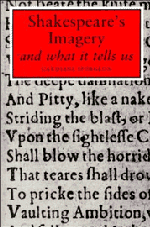Summary
Difficulties connected with the counting and classifying of images
The difficulties and problems connected with the counting and classifying of images could hardly be believed by one who has not experienced them. Probably no two people would entirely agree as to the number of images to be found in any one play. First, there is the question as to whether what we are considering is an ‘image’ at all, or not? Secondly, is it one image, or two, or three? Thirdly, is it one image with a subsidiary idea, and if this, how should it be classified?
As I worked, it soon became clear that some images, although they form only one image, must be entered, for purposes of reference, under two headings, one main heading and one subsidiary, the subsidiary one being called a ‘cross-reference’. Thus
The caterpillars of the commonwealth,
Which I have sworn to weed and pluck away
has as a main heading, ‘insects, caterpillars’, and as a subsidiary heading or cross-reference, ‘gardening, weeding’. But in the count of images in the play as a whole (in the charts or in tables) it is reckoned as one image only, under the heading of ‘insects’. At the same time, in examining the ‘leading motives’ in the images, I have made full use of these ‘cross-references’. For example, in Hamlet, I have quoted as showing Shakespeare's imaginative interest in disease or sickness, images such as
O, my offence is rank, it smells to heaven,
which is really classified under ‘senses, smell’; or
diseases desperate grown
By desperate appliance are relieved
Or not at all,
which has, as a main heading, ‘proverbial’.
- Type
- Chapter
- Information
- Shakespeare's Imagery and What it Tells Us , pp. 357 - 384Publisher: Cambridge University PressPrint publication year: 1935



